PROJECT
Jet 2.0 - Category Experiences
SUMMARY
120 days. This is the total number it took to rally troops, focus and build what has been dubbed as “Jet 2.0”. This required alignment from multiple cross-teams in order to pull off. Each move mattered and it culminated in company excitement, premium brands jumping on-board and a brand new Jet category experience.
ISSUE
The primary issue that Jet 2.0 set out to solve was how to differentiate the purchase experience from one category to the next. You don't buy your 65" 4K television the same way you buy paper towels or milk. Yet, there was no difference in the shopping experience prior to Jet 2.0.
Additionally, through research, we found an opportunity to serve the urban, metro resident who deals with the perils of city living.
This provided the platform for what the new Jet.com online shopping experience may look like. Specifically broken into two experience focuses: 1) City Grocery 2) Non-Consumable priority categories. I was tasked with overseeing the experience for 4 non-consumable priority categories:
-
Home
-
Fashion
-
Beauty
-
Electronics
SOLUTION
The proposed solution was a design led initiative. Miguel Fernandez, Head of Design, identified and crafted a narrative of "Differentiation" that was proposed to Executive Leadership. I assisted in visualizing the concept for category specialization.
“Project Leapfrog” designed a new browsing experience specific to each key category. The basis were 5 key brand principles to aim for:
-
Thoughtful Curation
-
Invite Discovery
-
Establish Connections
-
Empower the Customer
-
Humanize E-Commerce
The goal became clear: break from what made us fade into the market and look to break the mold for what was expected. Jet would focus on urban, metro customers and solve their shopping needs. Staring in New York City, but plan to scale to other metro centers like Boston, Washing D.C., Los Angeles, Chicago, etc.
The following work outlines a portion of the 120 day relaunch effort that went live on September 18, 2018.
PLATFORMS
Desktop
Mobile/Tablet Web
iOS
Android
ROLES
UX Stakeholder
Lead UX Design
Project Evangelist
User Testing
Cross-function Collaborator
Workshop Moderator
TEAM
Miguel Fernandez - Head of Design
Paula Guzman - Sr. UX/UI
Mabel Liang - Sr. UX/UI
Michael Vitale - Sr. UX, Content
Rich Przekop - Manager, PM
Annie Mercando - PM
Sean Marchetti - Manager, Tech
Alyssa Dixon - Manager, Content
Eurie Kim - Director, Creative
TOOLS
White Boards
Dropbox Paper
Sketch
Zeplin
InVision Prototype
React JS
Storybook
PowerPoint
Jet.com Before
Jet.com After

DISCOVERY
The core of the new Jet 2.0 experience was rooted in insights around a new persona and set of behaviors. Through ethnography research, workshops and data collection, our category teams focused in on new experiences.






PERSONAS
Through research and data collection, a primary persona emerged as our design target. "Lizzy" embodied the qualities and characteristics of the "urban, metro resident". Jet 2.0 would be focused on Lizzy going forward.

MISSIONS & INTENTIONS
With a focus on the persona "Lizzy" each primary category was considered a "Mission". Within each mission were 3 prime "Intentions" that were drivers for shopping wants/needs.




JET 2.0 FOCUS
Through insights and analysis, our differentiators were defined as follows: Break the mold of the old and begin anew.

FRAMEWORK
In order to design Jet 2.0, we utilized the Jet Design System (JDS) to refer to established patterns. We then added a framework for content considerations as well. This allowed for category specialization and understanding.

WIREFRAMES & DESIGNS
Taking all of the framework concepts and applying category considerations, my team and I generated wireframes for Home, Fashion, Beauty & Electronics. These concepts would prove to be the groundwork for final launch pages.
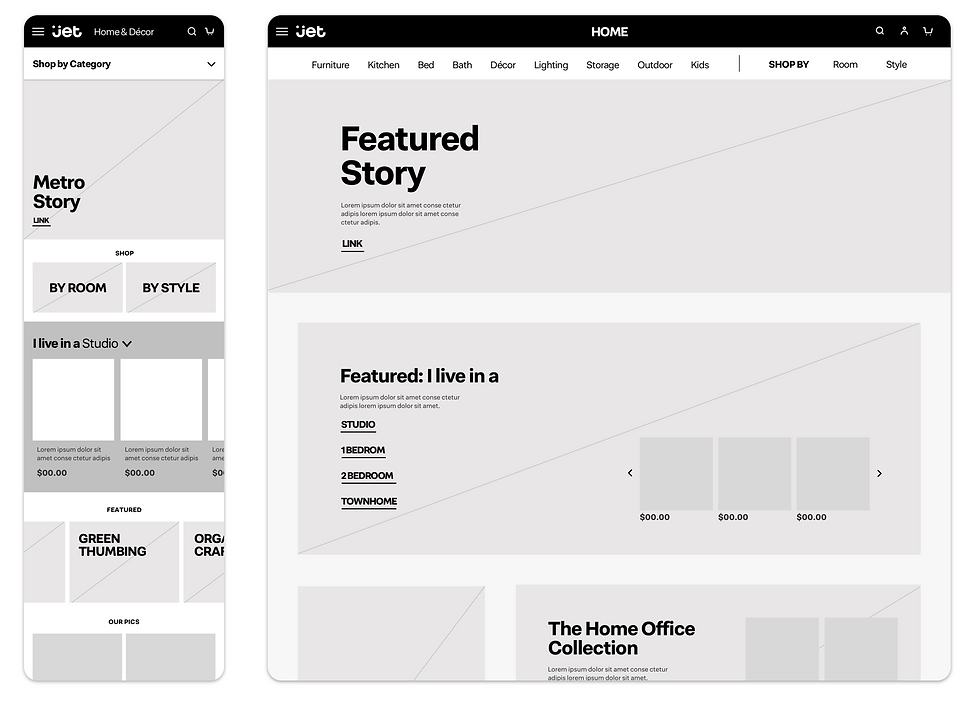
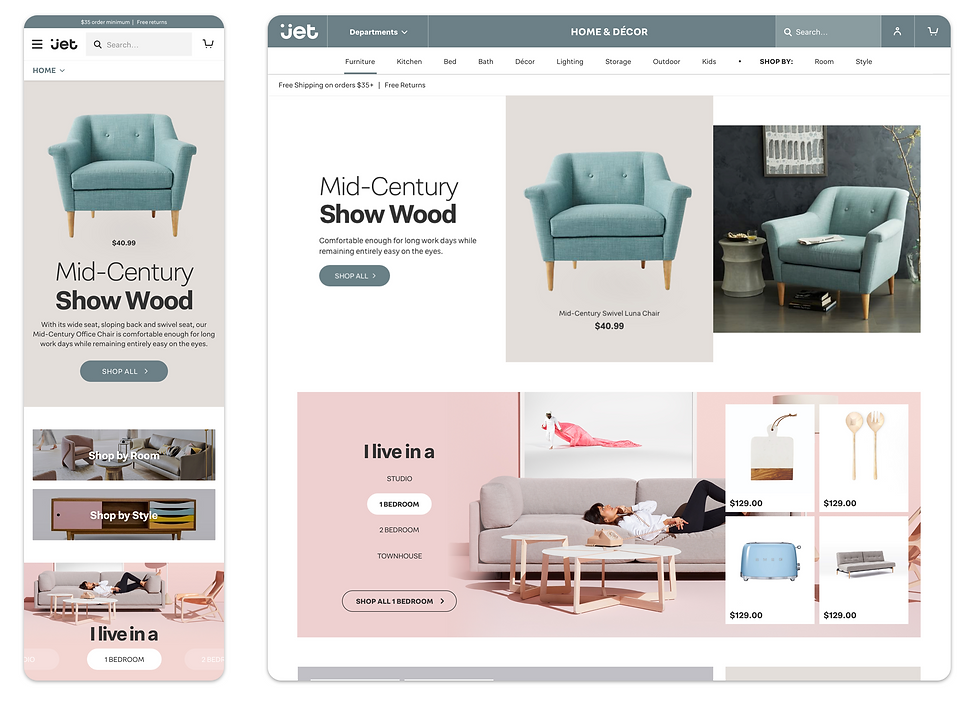
CATEGORY SPECIALIZATION
As each category was considered, I led competitive analysis exercises with the team as well as explorations into what a specialized experience would look like. This one helped us cement a premium brand partnership with Nike. Jet 2.0 was already succeeding.
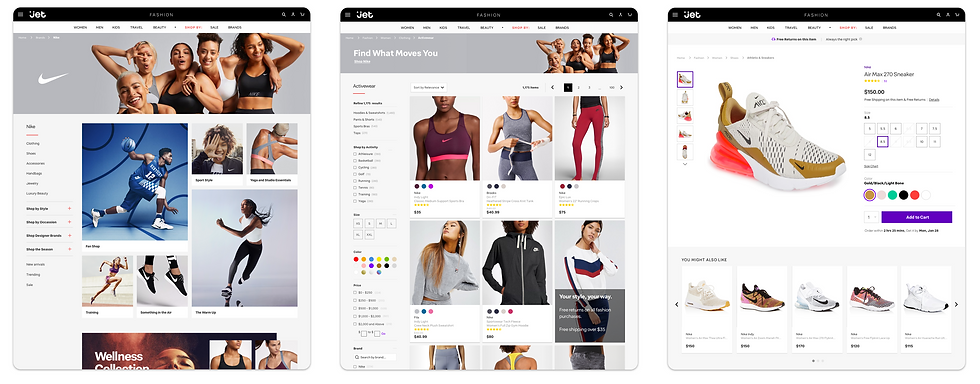
DESIGN & EXPERIENCE REVIEWS
The evolution of Jet 2.0's design was a collaborative effort across the organization. Multiple workshops and exercises invited various stakeholders to see and express ideas. This process truly refined the look and feel.
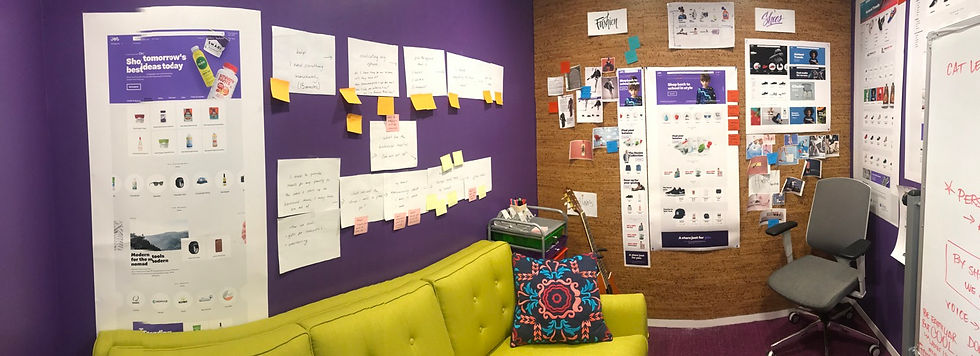
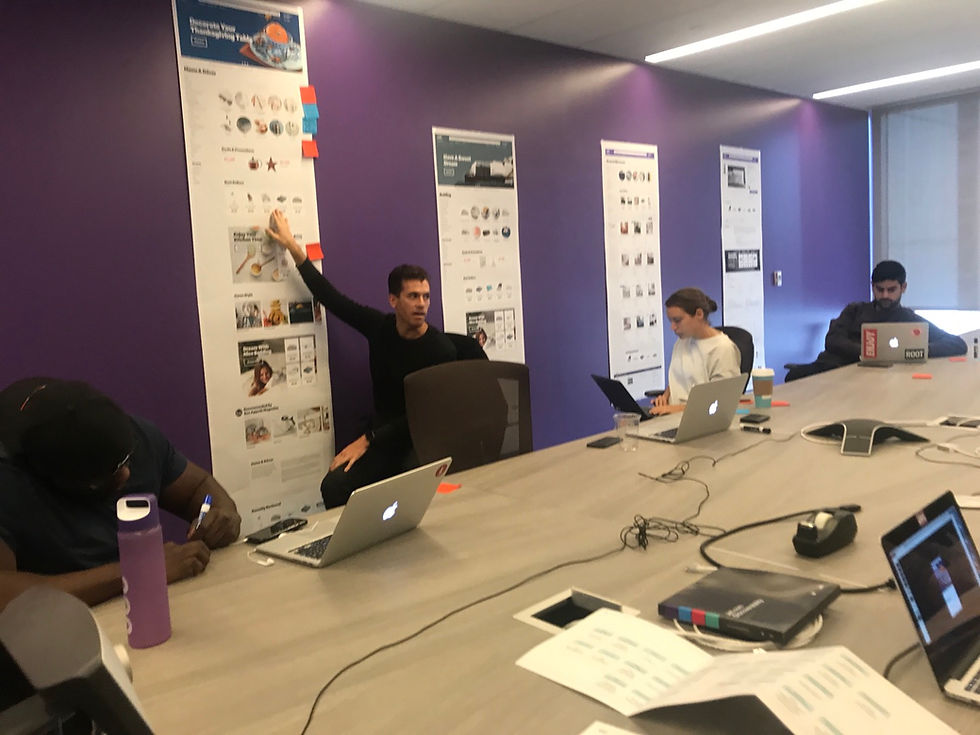




CATEGORY EXPERIENCE
Through multiple rounds of design, testing and insights, the category experiences became focused as "Missions". The design reflected this with the help of JDS principles and frameworks.

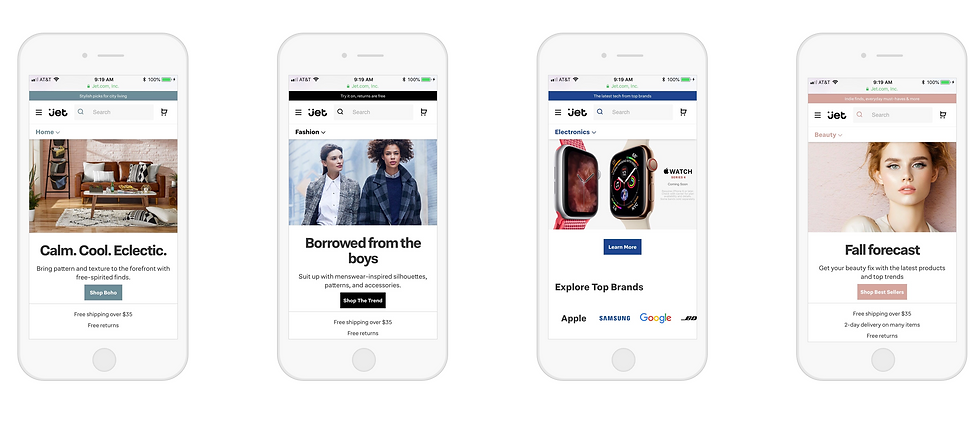
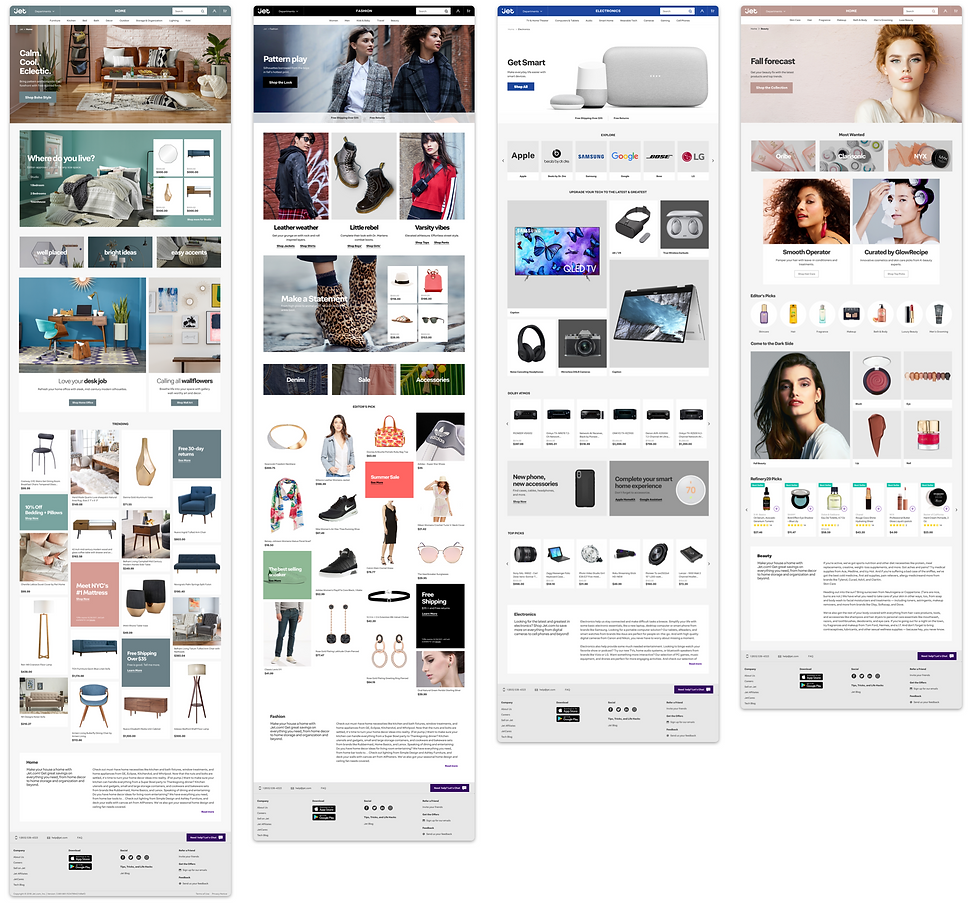
LAUNCH COVERAGE
The market took notice of our relaunch and we pushed information about our new focus for the urban, metro shopper.

USER TESTING & FEEDBACK
As part of the post-launch insight plan, our research team dedicated weekly testing sessions to gauge user feedback and comments. I checked in weekly with Customer Care leads at the Jet.com Call Center in Salt Lake City, UT.

Favorable Insights
-
Customers found the site more "shoppable" than before
-
Customers appreciated the elevated look and feel
-
Customers felt the site to be more "personal"
-
Customers appreciated new top brands and NY focus
Issues & Opportunities
-
Not immediately clear Jet is a shopping site (new users)
-
Customers want assortment to match the look and feel
-
Customers felt value proposition to be minimal/average
-
Search was difficult and site speed felt too long on pages
CONCLUSION
At midnight on September 18, 2018, Jet 2.0 was released to the public. 120 days after the teams kicked off efforts, the new Jet.com shopping experience and business focus was in the wild. The launch was met with great acclaim across the industry as Jet looked to differentiate from parent company Walmart, but also carve out a new niche in the e-commerce genre.
Key wins from the work I led included:
-
Excitement around new look and experience saw new key premium brands join Jet.com's assortment. Namely: Nike, Apple, Bonobos, Adidas and Crate & Barrel
-
User feedback has been enthusiastic about the relaunch look and feel of Jet.com. Aside from minor issues due to the size of the launch, NPS indicators showed promoters for the site experience and look/feel.
-
Organizational alignment that was non-existent before became the key to success. New relationships forged meant bigger opportunities going forward
-
Jet Design System (JDS) was included in the code base for launch meaning true integration beyond theory of UX/UI principles between Design, Product and Tech
However, several experiences did not roll out as smoothly:
-
Search within the new experience was confusing and had to scale back "in-category" defaults for the 4 non-consumable categories
-
The grocery delivery experience had a lot of kinks to work out due to the new warehouse, but also dealing with new fee structure
-
Users found it difficult to find previous pathways. Thus revisions to several design decisions were updated following launch
Overall, there were some insightful lessons from the Jet 2.0 relaunch efforts. Key metrics remained flat for the better part of 3 months, accomplishing the initial goal of not adversely affecting sales performance. Additionally, the site was launched just before the Holiday 2018 season which is the highest volume period for e-commerce. Jet.com stood up to the test and allowed merchandisers and marketers to tell our urban, metro story through the web and native apps.